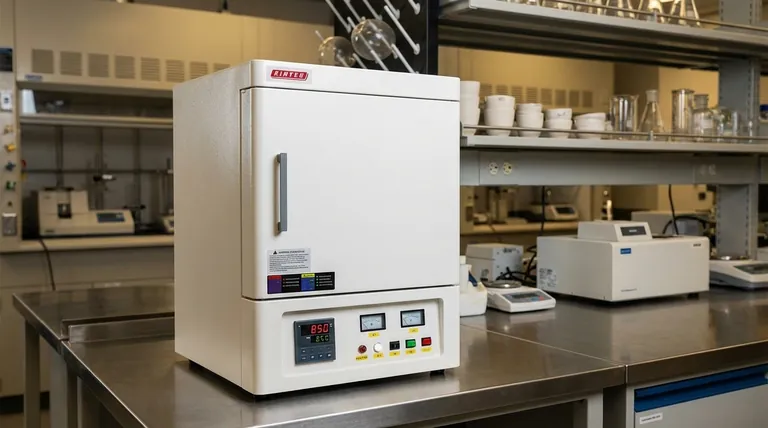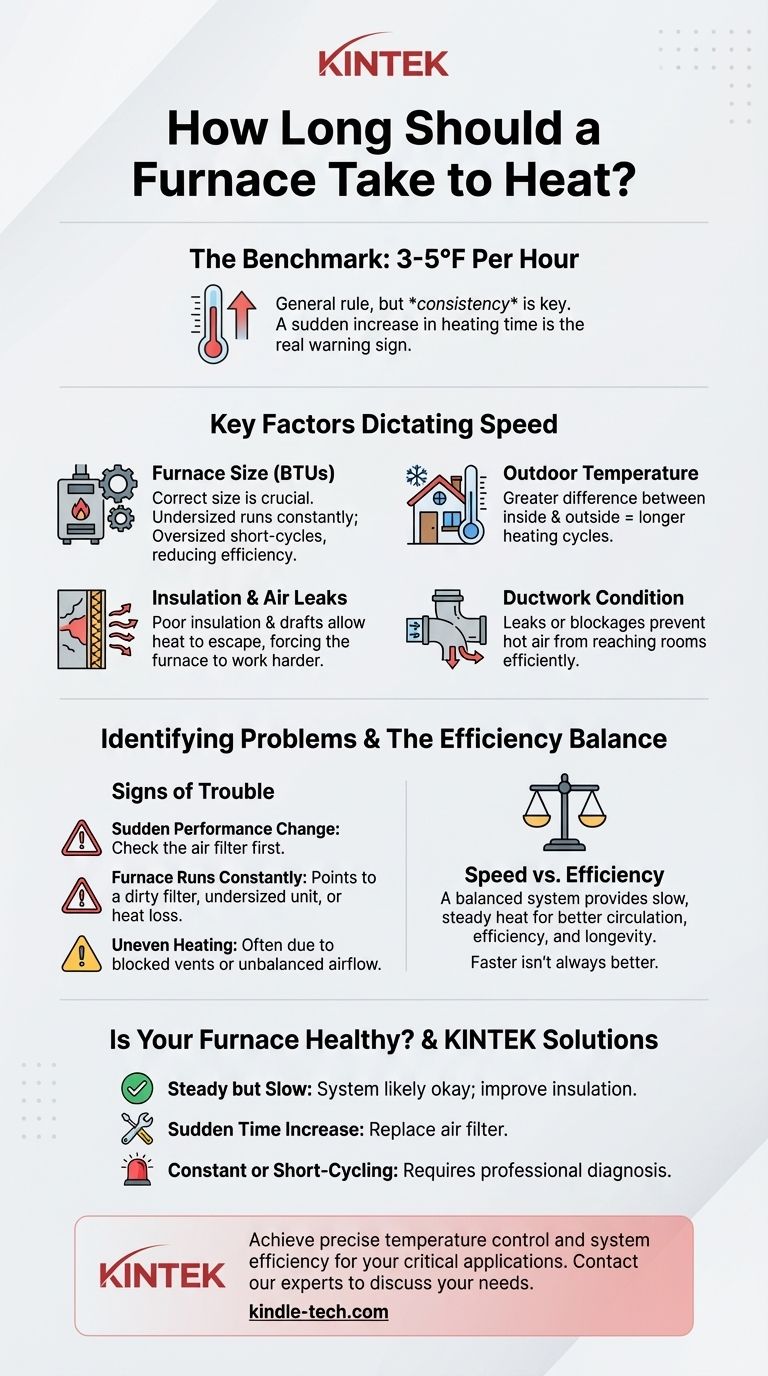As a general benchmark, a properly functioning furnace should be able to raise the indoor temperature by 3 to 5 degrees Fahrenheit per hour. However, this is not a universal standard. The actual time can vary significantly based on factors like the outdoor temperature, the size of your home, and the condition of your insulation and ductwork.
The critical metric isn't a specific number of minutes per degree, but rather the consistency of your furnace's performance. A sudden and noticeable increase in the time it takes to heat your home is the most reliable indicator that your system requires attention.

Key Factors That Dictate Heating Speed
Understanding why your furnace performs the way it does requires looking at the entire heating system, not just the furnace itself. Several interconnected elements determine how quickly and efficiently your home is heated.
Furnace Size and BTU Output
A furnace's heating capacity is measured in British Thermal Units (BTUs). A correctly sized furnace is essential for efficient operation.
An undersized furnace will run constantly on cold days, struggling to reach and maintain the temperature set on your thermostat.
Conversely, an oversized furnace will heat a small space too quickly and shut off. This phenomenon, known as short-cycling, causes inefficient temperature swings and premature wear on components.
Outdoor Temperature and Climate
The most straightforward factor is the weather outside. Your furnace has to work much harder to raise the indoor temperature by 10 degrees when it's 10°F outside compared to when it's 40°F.
The greater the temperature difference between inside and outside, the longer the heating cycle will be.
Home Insulation and Air Leaks
Your home's ability to retain heat is arguably as important as the furnace's ability to produce it.
Poor insulation in walls and attics, along with drafts from old windows and unsealed doors, allows the heat your furnace generates to escape. This forces the system to run longer and more frequently to compensate for the constant heat loss.
Ductwork Condition
Your ductwork is the delivery system for heated air. Leaks, blockages, or poor designs in the duct system can be a major source of inefficiency.
If a significant portion of the hot air is leaking into your attic or crawlspace, it never reaches the intended rooms, drastically increasing the time it takes to feel warm.
Identifying the Signs of a Problem
Instead of timing your furnace with a stopwatch, focus on observing its behavior over time. These changes are much better indicators of a potential issue.
A Sudden Change in Performance
This is the most important signal. If your home used to warm up in 30 minutes under certain conditions and now takes over an hour, something has changed. The most common culprit is a clogged air filter, which restricts airflow and chokes the system.
The Furnace Runs Constantly
On a mildly cold day, your furnace should cycle on and off to maintain the temperature. If it runs continuously without shutting off, it's a clear sign that it cannot meet the heating demand. This points to a dirty filter, an undersized unit, or significant heat loss.
Uneven Heating
If you notice that some rooms are significantly warmer than others, the problem may not be the furnace itself but the air distribution. This is often caused by blocked vents, disconnected ducts, or an unbalanced system.
Understanding the Trade-offs: Speed vs. Efficiency
Many homeowners mistakenly believe a faster furnace is always a better one. However, the goal of an HVAC system is to achieve a balance between comfort, efficiency, and equipment longevity.
The Problem with Oversizing for Speed
A furnace that is too powerful will blast the area around the thermostat with hot air, satisfying it too quickly. The system shuts down before it has had a chance to circulate warm air to the far corners of the house, leading to uncomfortable hot and cold spots. This constant starting and stopping also consumes more energy and wears out parts faster.
The Goal is a Balanced System
A correctly sized furnace provides a slow, steady, and consistent supply of heat. It may run for longer cycles, but this allows for proper air circulation, resulting in a more even and comfortable temperature throughout the entire home. This method is also more energy-efficient and better for the lifespan of your equipment.
How to Determine if Your Furnace is Healthy
Use these points to assess your system's performance and decide on the right course of action.
- If your furnace seems slow but heats steadily and evenly: Your system is likely functioning as intended. To improve performance, focus on sealing air leaks and improving your home's insulation.
- If your furnace's heating time has suddenly increased: The first and easiest step is to check and replace your air filter. A dirty filter is the most common cause of reduced airflow and poor performance.
- If your furnace runs constantly or short-cycles frequently: This suggests a more significant problem with sizing, airflow, or the unit itself, and warrants a professional diagnosis from a qualified HVAC technician.
Ultimately, a healthy heating system is defined by consistent and reliable performance, not by a race against the clock.
Summary Table:
| Factor | Impact on Heating Speed |
|---|---|
| Furnace Size (BTU Output) | Undersized: struggles; Oversized: short-cycles, inefficient |
| Outdoor Temperature | Greater difference from indoor temp = longer cycle time |
| Home Insulation & Air Sealing | Poor insulation leads to heat loss, increasing heating time |
| Ductwork Condition | Leaks or blockages prevent heated air from reaching rooms |
Is your furnace running constantly or taking too long to heat your home?
Your heating system's performance is critical to your comfort and energy bills. KINTEK specializes in providing high-quality laboratory equipment and consumables. While our primary focus is on lab environments, we understand the importance of precise temperature control and system efficiency. If your work involves thermal processes or environmental testing, ensuring your equipment operates consistently is key.
Contact our experts today to discuss your specific needs. Let KINTEK help you achieve reliable and efficient performance for your critical applications.
Visual Guide

Related Products
- 1800℃ Muffle Oven Furnace for Laboratory
- 1400℃ Muffle Oven Furnace for Laboratory
- 1700℃ Muffle Oven Furnace for Laboratory
- Laboratory Muffle Oven Furnace Bottom Lifting Muffle Furnace
- 1400℃ Laboratory Quartz Tube Furnace with Alumina Tube Tubular Furnace
People Also Ask
- How is the ash content determined in a muffle furnace? Master the Gravimetric Analysis Method
- What are the conditions for a muffle furnace? Ensure Safety, Performance, and Longevity
- What is a laboratory furnace called? A Guide to Muffle and Tube Furnaces
- What is the difference between a muffle furnace and a normal furnace? Ensuring Sample Purity with Indirect Heating
- What are the disadvantages of a muffle furnace? Understanding the Trade-offs for Your Lab



















